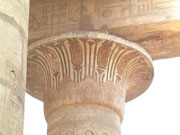TOUR NEWS - TURKEY MAY 2010
At the end of April I headed to Istanbul to meet up with the group which was touring ancient Turkey. I had 10 days in the area of Istanbul and really enjoyed exploring more of this wonderful place. A visit to Bursa enabled me to revisit the impressive early Ottoman mosques in the city and the revamped covered markets. I also had a chance to visit the important ancient and mediaeval site of Nicea (modern Iznik) - the walls around the city are very impressive and the ancient Roman city is surely preserved under the modern town. A visit to Edirne, north of Istanbul, provided a further chance to explore early Ottoman mosques and markets.
The group came together in Istanbul on the 9th May and included: Brenda Wass, Robert Tonner, Janet Stewart, Yvonne Stuckey, Lynn Gough, Tom and Jan Lockley, and Graham and Anne Spurway. The program was led by me, Michael Birrell, with the assistance of our new Turkish guide Tanner Ildiran who did an excellent job of informing us about life in modern Turkey.
Our first day in Istanbul examined the ancient Byzantine treasures of the city. This includes the antiquities of the Hippodrome and the awe inspiring Basilica Cisterns, the huge underground water storage facilities created by the Emperor Justinian. We had lunch in a nearby restaurant and in the afternoon we spent a few hours in the magnificent Haghia Sophia church. Initiated by the Byzantine Emperor Justinian it was converted into a mosque after the Muslim conquest of Constantinople in 1453. We had dinner in a restaurant located on the roof terrace with 360 degree views of the Sea of Marmara, Bosphorus and Golden Horn. The following day we explored Topkapi Palace, home to the medieval Sultans and the Ottoman royal court in Istanbul. The palace is famous for its marvellous harem rooms, lined with sumptuous Iznik tiles, and the treasures of the Ottoman Sultans. We had lunch at a restaurant overlooking the Bosphorus Straits. In the afternoon we explored part of the Grand Bazaar with its incredible maze of shops.
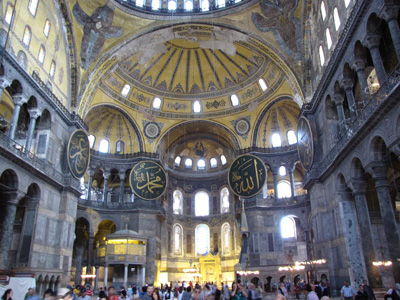 |
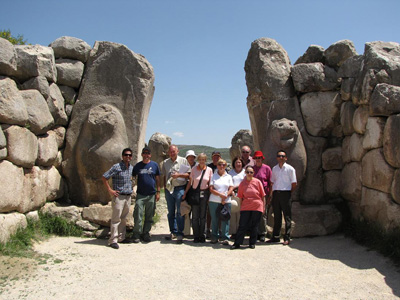 |
The newly restored Haghia Sophia basilica |
The May 2010 Turkey Tour group at the Lion Gate Hattusas |
In the morning we travelled by bus to Ankara, passing along the Sea of Marmara and through scenic upland country. In the afternoon we saw the war museum and impressive mausoleum of Kamal Ataturk, founder of the modern nation of Turkey. The following morning we visited the Ankara Museum of Anatolian Civilizations, home to an impressive collection of artefacts representative of Turkish history from the Palaeolithic Era down to the Roman period. Of particular interest are the neo-Hittite reliefs from Carcamesh and the Assyrian letters from Kultepe Kanesh. In the afternoon we drove north east of Ankara to our hotel near Bogazkale.
The following day, the 13th May, was dedicated to the ancient Hittite capital of Hattusas. We made a full tour of the ancient city, highlights including the royal citadel, the Great Temple and the impressive city gates. After a picnic lunch near the royal citadel we visited the rock-cut shrine of Yazilikaya which preserves remarkable representations of the Hittite pantheon. Our Hittite study continued the following day when we visited the nearby site of Alaca Huyuk, an ancient fortified Hittite town with Early Bronze Age tombs. We then travelled south by bus to the fascinating region of Cappadocia, famous for its remarkable landscape of natural 'fairy chimneys' made from volcanic pumice. We took a short diversion from our intended route to see the impressive and interesting remains of the Middle Bronze Age site of Kultepe (ancient Kanesh) and saw the remains of the karum or Assyrian trading colony dating back to around 2000 BC. We then checked into our hotel in the town of Urgup.
A day was spent exploring some of the wonderful landscapes of Cappadocia - in the morning we saw the site of Goreme which is famous for its remarkable underground painted churches carved from the volcanic pumice. We then travelled by bus to the ruins of the ancient settlement of Zelve, home to a monastic community in the Middle Ages. The inhabitants cut their houses and the monasteries from the pumice and protected their dwellings by movable boulders. The landscape is like something out of Tolkien�s �Lord of the Rings�
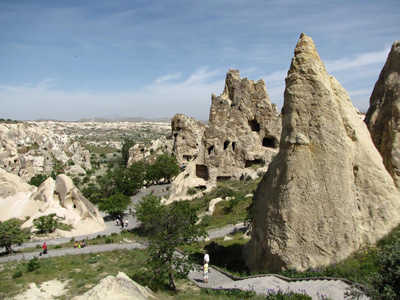 |
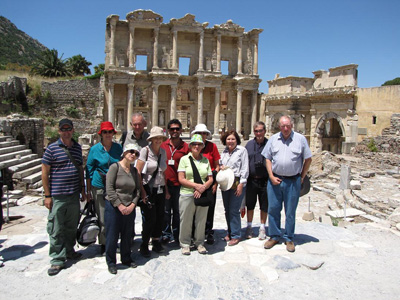 |
The �fairy chimneys� of Cappadocia |
Exploring the ruins of Ephesus |
The following morning there was time to rest and relax - some members of the group went for a hot air balloon ride over the fairy chimneys of Cappadocia. In the afternoon we drove to Ankara and flew from there to Izmir driving the short distance by bus to the picturesque town of Selcuk. We checked into our local family run pension, the Nazar Hotel, which was to be our base for the following 6 nights.
The 17th May was devoted to exploring the remarkable ruins of Ephesus. We wandered round the city, admiring the small theatre, the marble monuments of Curetes Street, the temple of Hadrian, the remarkable library of Celsus for which Ephesus is famous and the awe inspiring Hellenistic and Roman theatre. As a special part of our program, we visited the fascinating ruins of the wealthy private houses which preserve beautiful frescos and mosaics. We also saw the poor remains of the Temple of Artemis, originally one of the Seven Wonders of the Ancient World.
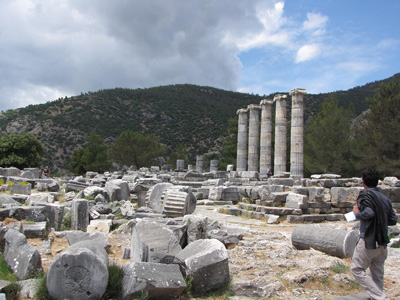 |
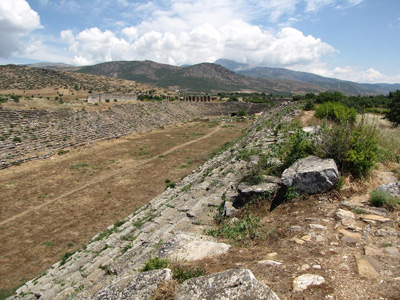 |
Exploring the Temple of Athena at Priene |
The stadium at Aphrodisias - magnificent! |
The next morning we travelled south by bus to the ruins of the ancient Hellenistic city of Priene, located on a dramatic hill overlooking the Meander River valley. There was some rain when we arrived so we had a much needed coffee and talked about the history of the area. When we finished the sun came out and we had this superb site virtually to ourselves. We explored the picturesque agora or town square, the town council hall, theatre, and magnificent Temple of Athena. We had lunch in a local town and then returned to Selcuk. In the afternoon we visited the local Archaeological Museum, home to a magnificent collection of Classical and Roman sculpture from Ephesus and surrounding sites.
The next day we ventured south by bus from Selcuk to see the ancient cities of Miletus and Didyma. The morning was spent at Miletus where we have a chance to wander around the picturesque ruins. Highlights included the monumental Hellenistic and Roman theatre, the agora and the well preserved Baths of Faustina. After lunch at Didyma we saw the awe inspiring ruins of the Temple of Apollo, one of the largest temples in the Classical world and once home to a famous oracle. Our study of the monuments in the local area concluded with a visit to the ancient site of Aphrodisias, cult centre of the famous goddess of love. This is gorgeous place, set in a lush green area of the Meander River, and the site is renowned for its remarkably well preserved Roman stadium, theatre and agora (marketplace). We had a very pleasant picnic lunch in the ruins of the stadium which was a highlight of the tour. After lunch we explored the museum with its impressive collection of Roman sculpture from the site.
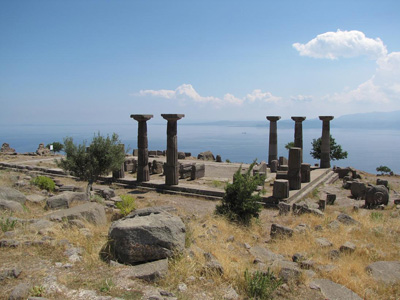 |
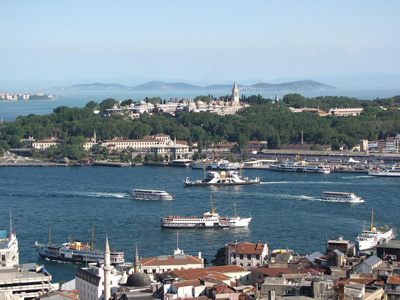 |
The Temple of Athena at Assos |
The view from Galata Tower towards Topkapi Palace |
There was a free day in our program to rest and relax. The next morning we headed north by bus to Bergama. We saw the impressive Red Fort (a temple to the god Serapis) and had some lunch before seeing the local Archaeological Museum of Bergama with finds from the area. The 23rd May was spent visiting the superb ruins of the ancient city of Pergamum. This ancient Hellenistic city was perched on the summit of a precipitous mountain and developed as a major centre of art and culture. Highlights of the day included the acropolis area with its royal palace, theatre, library and temple dedicated to the Roman Emperor Trajan. In the afternoon we visited the enclosure of Asclepeios, god of Medicine.
The next day we headed north by bus from Bergama. On the way we passed through some beautiful mountainous scenery and we made an detour to see the very picturesque ruins of the ancient city of Assos. The modern town was a delight and we had a pleasant fish lunch before climbing to the acropolis to see the impressive Temple of Athena and the magnificent views across to the Island of Lebos. From here we headed to the site of Troy - here we explored the remarkable ruins of this picturesque archaeological site, famously excavated by the German entrepreneur Heinrich Schliemann in the late 19th Century. At the site we saw �an Asklepios snake�, symbol of the god and incorporated today in the sign for a chemist. In the afternoon, after a short bus ride, we checked into our hotel in �anakkale on the Dardanelles Strait.
In the morning we crossed the Straits of the Dardanelles to the Gallipoli Peninsula. We explored the WWI battle fields of Gallipoli including Anzac Cove, Lone Pine and Chanuk Beyir. We had the chance to explore these dramatic locations and appreciate the incredible hardships of the fighters on both sides. In the afternoon we headed north by bus to Istanbul where we check into our hotel. The next day was dedicated to the scenic wonders of the region of Istanbul. In the morning we took the ferry from the Istanbul wharf up the Bosphorus Straits to the entrance to the Black Sea. We enjoyed a magnificent view of the city and the suburbs along the way. A wonderful view was also had from the Anadolu castle looking out into the Black Sea. We had lunch overlooking the water and then returned to Istanbul. In the afternoon we went to the top of Galata Tower, a mediaeval watch tower, for a breathtaking view across the Golden Horn - one of the most glorious views anywhere. On our last day in Turkey we visited the Blue Mosque, constructed in the early 17th Century by the Ottoman Sultan Ahmed I. Dominating the local area of the city, it is one of the great buildings of Islamic Istanbul. We also explored the Istanbul Archaeological Museum which houses artefacts from Troy and other significant sites in Turkey. In the afternoon there was time for last minute shopping. Our final meal was back at the Panorama Restaurant. We watched the sun set behind the Golden Horn and the moon rise over the Bosphorus - magic!
Michael Birrell
